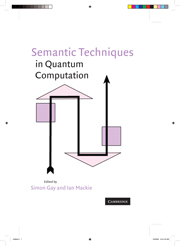Book contents
- Frontmatter
- Contents
- Contributors
- Preface
- 1 No-Cloning in Categorical Quantum Mechanics
- 2 Classical and Quantum Structuralism
- 3 Generalized Proof-Nets for Compact Categories with Biproducts
- 4 Quantum Lambda Calculus
- 5 The Quantum IO Monad
- 6 Abstract Interpretation Techniques for Quantum Computation
- 7 Extended Measurement Calculus
- 8 Predicate Transformer Semantics of Quantum Programs
- 9 The Structure of Partial Isometries
- 10 Temporal Logics for Reasoning about Quantum Systems
- 11 Specification and Verification of Quantum Protocols
- Index
- References
2 - Classical and Quantum Structuralism
Published online by Cambridge University Press: 05 July 2014
- Frontmatter
- Contents
- Contributors
- Preface
- 1 No-Cloning in Categorical Quantum Mechanics
- 2 Classical and Quantum Structuralism
- 3 Generalized Proof-Nets for Compact Categories with Biproducts
- 4 Quantum Lambda Calculus
- 5 The Quantum IO Monad
- 6 Abstract Interpretation Techniques for Quantum Computation
- 7 Extended Measurement Calculus
- 8 Predicate Transformer Semantics of Quantum Programs
- 9 The Structure of Partial Isometries
- 10 Temporal Logics for Reasoning about Quantum Systems
- 11 Specification and Verification of Quantum Protocols
- Index
- References
Summary
Abstract
In recent work, several researchers including the authors have developed a categorical formalization of quantum mechanics in terms of symmetric monoidal dagger categories. In this framework, classical data turned out to be represented by an algebraic structure, that of special commutative dagger Frobenius algebras. This structure captures the distinct capabilities that apply to classical data – that they can be copied and deleted. In the present paper, we provide categorical semantics and diagrammatic representations of deterministic, nondeterministic, and probabilistic operations over classical data represented in this way.
Moreover, a combination of some fundamental categorical constructions (the Kleisli construction of the category of free algebras and the Grothendieck construction of the total category of an indexed category) with the specific categorical presentations of pure and mixed quantum states provides a resource-sensitive categorical account of classical control of quantum data and of classical data resulting from quantum measurements, as well as of the classical data processing that may happen in between measurements and controls. Along the way we also discover some apparently novel quantum typing structures.
One of the salient features of categorical quantum mechanics is still its graphic calculus, which allows succinct presentations of diverse quantum protocols. The elements of an abstract stochastic calculus are beginning to emerge from it, pointing toward convenient refinements of resource-sensitive logics that are hoped to capture the probabilistic content and limited observability of quantum data.
- Type
- Chapter
- Information
- Semantic Techniques in Quantum Computation , pp. 29 - 69Publisher: Cambridge University PressPrint publication year: 2009
References
- 23
- Cited by



